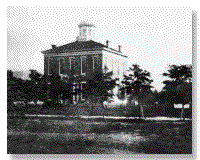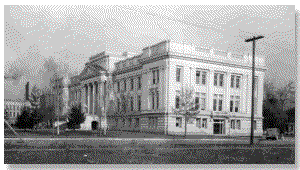Courthouse History
Circa 1866
In 1860, $2,000 was appropriated to build a courthouse. This was Provo's first building constructed to be used as a courthouse. The one-story brick structure was started in 1866 and finished in 1867 at a cost of $5,092.16. It was built on First West between First and Second North.
It served as a jail and courthouse for five years and then was sold to the Provo Woolen Mills. A notable event in the history of this building was the trial, conviction, and execution of Chauney M. MIllard on January 26, 1869. He was executed for the murder of two herders north of Utah Lake while people, filling the square, watched.
Circa 1872
In 1870, Provo City posted bids for the construction of a new courthouse. The work on this building began in 1872 and was completed in 1873 at a cost of $21,478.80.
Brigham Young was at the dedication of the Courthouse on October 14, 1873.
The building was constructed facing north on Center Street on City and County land. The contractors were paid one-third in cash, one-third in grain, and one-third in shares of Provo Woolen Mills stock. By 1919, the courthouse was found to be too small for the needs of the growing city and county, and plans were then made to construct a new and larger city and county building. It was razed between 1919 and 1920 when the present Courthouse building was begun in 1920.
While the present courthouse was under construction, court sessions were held on the third floor of the Knight building.
1920 to the Present Day

In the early part of 1919 the citizens of Utah County and Provo City respectively voted bonds for the erection of a new joint city and county building to be built in Provo. The agreement between the two corporations was that the county should pay for two-thirds of the building and occupy a corresponding portion of it, while the city should pay one-third of the building.
The city and county officials jointly engaged Joseph Nelson of Provo as the architect for the building.
It was decided that a tour of the west coast be taken to see what had been done in other communities in the way of administrative buildings. On July 9, 1919, a party of city and county officials and the architect left for California. Visits were made to various localities of interest from Los Angeles on the south to Everett, Washington, on the north. This trip largely determined the type, size and cost of the building that was to be erected.
On October 13, 1919, a meeting of city and county officials and an appointed building committee was held wherein sketches of the building were presented by the architect. After discussion and suggested improvements the sketches were accepted and the architect was directed to get the working drawings completed as soon as possible, and to get bids for the lower portion of the building. In the meantime the question of location and finally the direction the building was to face was decided.
Bids for the construction of the ground floor of the building were called for on June 18, 1920; bids were opened and the contract for this portion of the building was let to Rudine and Chytraus, contractors of Salt Lake City, they being the lowest bidder.
The corner stone of the building was laid in the presence of a large gathering on December 14, 1920. During the progress of this portion of the construction minor contracts were carried on in connection therewith for heating, plumbing and electrical work.
In the meantime the work of finishing the plans and specifications for the entire building was carried on and bids were advertised for the completion of the super-structure. On June 22, 1921, bids were opened by the commission and the contract was awarded to Rudine and Chytraus, the low bidders.
The work was carried on by Rudine and Chytraus and mainly finished at the end of the year 1922, but some carving and other minor jobs carried into 1923. In the fall of 1922 bids were taken for the completion of the building and the contract was again awarded to the low bidders, Rudine and Chytraus. In the spring of 1923 Rudine and Chytraus returned from California to take up the work. Upon their arrival the chairman of the county commission refused to carry on the contract and settlement was finally made with the contractors and the agreement cancelled.
Bids were taken for the roughing of the plumbing and heating, and a contract was let on September 30, 1924, to P. L. Larsen of Provo. On November 30, 1924, a contract was let for the putting in of the lower floor to C. A. Tolboe of Provo. Bids for the completion of the building were again advertised and opened on June 14, 1925, The general contract was awarded to C. A. Tolboe of Provo.
The work was begun in the spring of 1919 and completed in the late fall of 1926, so that the time consumed in the work is a little more than six and one-half years.
The pediment is filled with an exceptionally fine group of sculpture designed by Architect Joseph Nelson and carved from the solid stone in the full round by Joseph Conradi, sculptor of Salt Lake City. This group is symbolic and has been made to tell the story of the building.
Here is the story of the group as the architect conceived it:
"The building is a courthouse, therefore, quite consistently, Justice stands with her balances resting upon the law, in one hand, and with her sword in the other. The building is also to house the city and county offices, therefore, on the right hand of Justice sits a woman representing the County, supporting with one hand a shield bearing the inscription, 'County of Utah' and in the other a cornucopia, or horn of plenty, overflowing with the good things produced in the region. Then the various arts and industries are represented at her side. Her horticulture is represented by the fruit trees; her dairying and stock raising by the front quarters of an animal projecting beyond the tree; her mining by the pick and shovel at the side of the tunnel entrance to the mine in the mountain; and further down, her sheep raising and poultry farming, respectively."
"On the other side of Justice sits likewise Provo City, enthroned and supporting a shield with the inscription 'City of Provo', emblazoned thereon. She is flanked by the harp and the viol, the vase, the cogwheel, a stack of books, and an artist's palette; these represent her arts, her industries, and her educational advantages."

